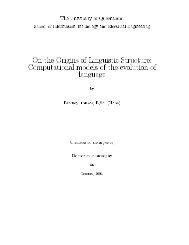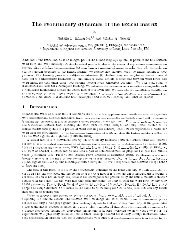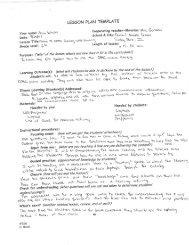Planning and Managing an Exhibition Programme
Planning and Managing an Exhibition Programme
Planning and Managing an Exhibition Programme
Create successful ePaper yourself
Turn your PDF publications into a flip-book with our unique Google optimized e-Paper software.
:ious metals<br />
)9 published<br />
,f that year's<br />
The Royal<br />
'entury drew<br />
raging 8,555<br />
rho attended<br />
iom 8am on<br />
show at the<br />
ribition uP to<br />
:xhibition for<br />
visitors dailY<br />
r nine-month<br />
to 20,000 ft2<br />
rlleries nearbY<br />
ry space when<br />
:fice to receive<br />
.er institutions<br />
rnd exhibition<br />
'was sufficient<br />
rer exhibitions<br />
:amme capable<br />
at least 5,000<br />
f1z (9. 1,200 to<br />
reed to provide<br />
museum or in<br />
'nger periods at<br />
:n available for<br />
r week after for<br />
a year would be<br />
nly 5,000 ft2 (c.<br />
rrary exhibition<br />
.ckage shows to<br />
rsed by pl<strong>an</strong>ning<br />
re or two others,<br />
xL<br />
*<br />
3<br />
n fi<br />
:<br />
i<br />
B,<br />
ii<br />
Y<br />
i:<br />
i<br />
h<br />
I<br />
i;<br />
i<br />
t:<br />
scheduling those for several months' duration, but of course those exhibitions require<br />
more staff time <strong><strong>an</strong>d</strong> expertise.<br />
Thus, in addition to projecting the proportionate sources of exhibitions to be<br />
shown, the <strong>Exhibition</strong> Policy should ensure that the museum or exhibition centre<br />
provides only the temporary exhibition gallery capacity that c<strong>an</strong> reasonably be<br />
programmed, considering not only space <strong><strong>an</strong>d</strong> facility limitations, but also budget, staff<br />
<strong><strong>an</strong>d</strong> time available. One solution was found by the new Frist Center for the Visual Arts<br />
in Nashville, which has renovated 12,000 ftz (c. 1,,200 m2) on its ground floor for<br />
temporary exhibitions, but is utilising its 8,000 ft2 (c. 800 m2) upper floor galleries<br />
for longer-term rotation of works of art on lo<strong>an</strong>, with that additional space available<br />
when needed for blockbusters.<br />
In practice, every museum operates a mix of shows, often exemplifying all five of<br />
the levels of engagement listed here. The exhibition officer typically maintains a large<br />
wall calendar projecting the schedule of exhibitions, including time allocations for<br />
installation, demounting, packing <strong><strong>an</strong>d</strong> shipping dates. Museums with inadequate<br />
temporary exhibition space may face the added challenge of demounting perm<strong>an</strong>ent<br />
collection displays to make room for temporary exhibitions.<br />
Nor is display space the only requirement. The Art Institute of Chicago, for<br />
inst<strong>an</strong>ce, finds it necessary to have three or four smaller rooms adjacent to its temporary<br />
exhibition galleries to house audio-visual programmes, audio tour equipment, <strong><strong>an</strong>d</strong> a<br />
shop with stock dedicated to the subject matter of the ch<strong>an</strong>ging exhibitions. The latter<br />
has become a common me<strong>an</strong>s of revenue generation associated with major shows. As<br />
described in section 5.3 of this book, there is also the need for <strong>an</strong> entire suite of nonpublic<br />
support spaces - from the loading bay through a crating/uncrating area to a<br />
tr<strong>an</strong>sit store or temporary exhibition storage, not forgetting the associated security<br />
station, <strong>an</strong> isolation room (in case of infested crates), a documentation office,<br />
workshops for framing <strong><strong>an</strong>d</strong> mount-making, <strong><strong>an</strong>d</strong> <strong>an</strong> exhibition staging area where<br />
works of art, artefacts or specimens c<strong>an</strong> be installed in cases or on plinths to test case<br />
layouts before they go into the galleries.<br />
M<strong>an</strong>y museums find it necessary to meet the highest st<strong><strong>an</strong>d</strong>ards of functionalitS<br />
environmental controls, <strong><strong>an</strong>d</strong> security in these non-public temporary exhibition support<br />
spaces, in order to guar<strong>an</strong>tee their ability to borrow import<strong>an</strong>t exhibitions from major<br />
museums. Museum couriers - usually curators, registrars or conservators - often<br />
accomp<strong>an</strong>y major works of art on lo<strong>an</strong>, <strong><strong>an</strong>d</strong> their approval of these support spaces c<strong>an</strong><br />
be essential. Even if they do not come in person, directors, curators, conservators or<br />
registrars considering a lo<strong>an</strong> request routinely issue a form that requires the borrowing<br />
institution to describe these facilities in detail. Most collection policies require that<br />
lo<strong>an</strong>s c<strong>an</strong> be approved only to institutions that at least match the facilities <strong><strong>an</strong>d</strong><br />
PI.ANNING AND MANAGING AN EXHIBITION PROGMMME







